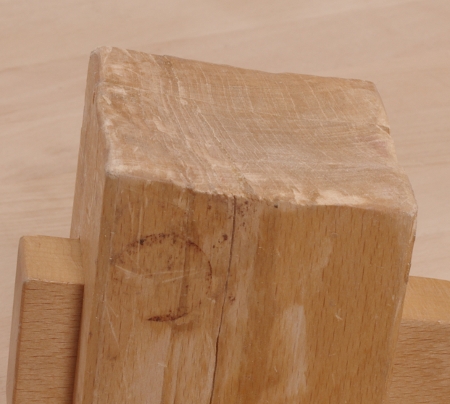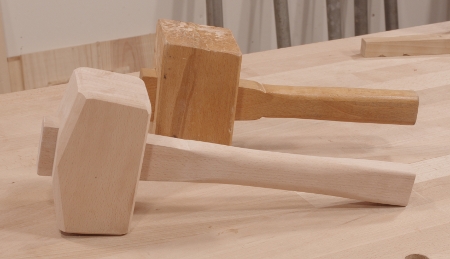My trusty mallet, Thagomizer, has really been taking a beating in the last year. I think I’ve had to glue it back up about four or five times now. With some extra time on my hands, it was time to build a replacement.
I liked a lot of things about the mallet, but did some silly things when I made it. The handle turns out to be a little too short, and for whatever reason, I put a finish on it. I guess I was on a varnishing kick back then; come to think of it, I really didn’t have anything else to varnish at the time. (I used rottenstone on this? Really?)
However, what interests me most is the question of if I could make a new one last longer. Everything on the original was very durable, except for the top of the head. It picked up a habit of splitting late in life. My first step was to take a good look at what had happened:

Notice that the face has become concave after repeated pounding. The fractures are all mostly in the top 1/3 of the head. I suspect that what’s going on here is that smacking something (like a holdfast) on the upper part of that concavity put a lot of shear force along the top, and that’s why it did what it did. Back in this post (way back when no one ever read this blog), I explained that I wasn’t going to put a bevel on the top because I was being lazy. So perhaps those bevels aren’t there just for show, and I knew one thing that I needed to do in the new one.
Because I didn’t have any really thick stock at the time, I built the old mallet by face-gluing pieces of wood. That turned out to be pretty durable, so I did the same thing this time, using the same trick to get the hole in the middle, except that I was considerably less meticulous about it:

I used a bunch of scrap wood this time (but from the same board as the old Thagomizer!), and decided that I cared only to (sorta) align the pieces on the bottom of the head because I’d just be chopping off massive pieces anyway. This might look a little stupid, but not nearly as stupid as what I did for the new handle:

I had the perfect piece of scrap, but it was just a tad too narrow, so I glued another piece of scrap to the end to get what I needed (and sawed most of it away in the end).
So I had the head and handle parts glued up, and it was time to shape everything. Here again, I was considerably less meticulous than last time. I sawed most of everything on the head, did the final passes on the top of the head with my jack plane with the deep camber, and chamfered the sides with that plane as well. As far as the handle goes, on the last one, I’d been all enthusiastic about using a spokeshave. Well, that spokeshave enthusiasm doesn’t happen nearly as often to a man who has a Shinto saw rasp in his hand. (Save the spokeshave for more delicate tasks.)
When everything was said and done (in a far less amount of time than the original), I had Thagomizer Jr.:

The top of the head is beveled down, the corners at the top are considerably chamfered, and the handle is a couple of inches longer. The head weighs a little less than the original, but the extra handle length probably brings it to about the same weight, but with a different balance.
So I’m ready to start beating on stuff now. Here’s a comparison of the original and new one:

Time and use will tell if the alterations do what they’re supposed to do.
Update: I broke this one, too. I wrote a post about its replacement.





